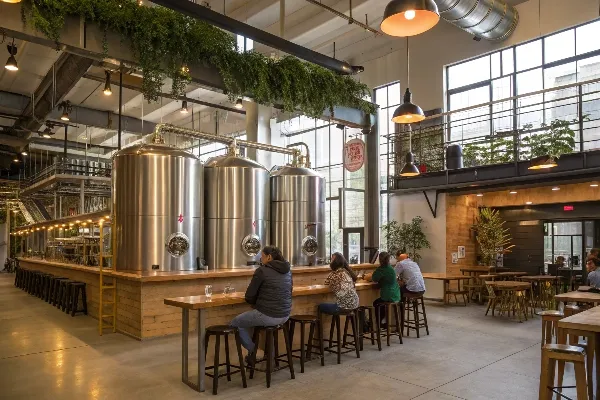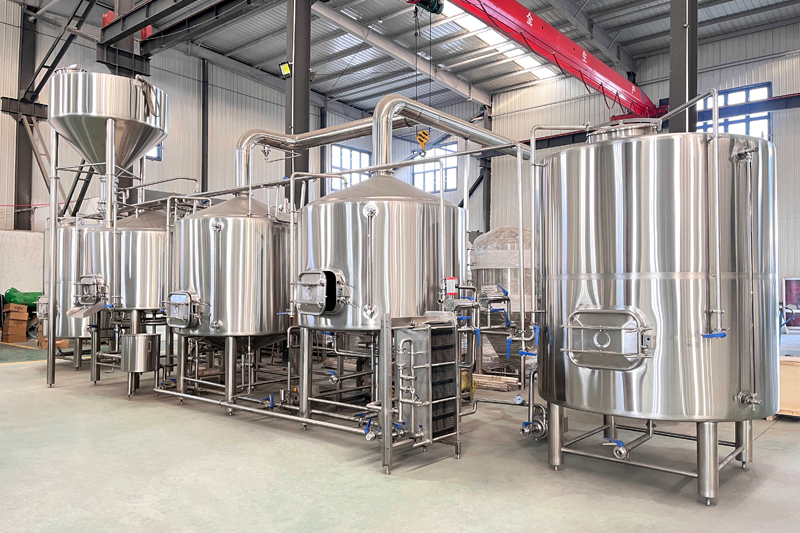Launching a microbrewery is a dream for many, but choosing the right brewing equipment is overwhelming. The wrong system leads to lost batches, inconsistent flavors, and wasted investment. Smart selection—built on data and real brewer experience—transforms your brewery’s success from day one.
Microbrewery brewing equipment includes specialized tanks and systems designed to brew, ferment, and condition beer on a commercial scale. Core components—brewhouse, fermenters, chillers, and brite tanks—work together for efficient, consistent, and high-quality beer production.
1. What Is Microbrewery Brewing Equipment?
Microbrewery brewing equipment is a collection of purpose-built machines and vessels, engineered to create top quality beer at scale. The essentials include:
- Brewhouse (often a 3-vessel system: mash tun, lauter tun, brew kettle)
- Fermenters (conical fermenters or unitanks)
- Brite tanks (for carbonation, maturation, and beer clarity)
- Glycol chillers (temperature management for fermentation and storage)
- Control panels (PID/PLC based for automation)
- CIP systems (Clean-In-Place, essential for hygiene)
- Process piping, hoses, tri-clamp fittings, spunding valves, and carbonation stones
- Ancillaries: keg couplers, heat exchanger, hoses, pressure gauge, oxygenation units, etc.
“The microbrewery equipment you choose sets the foundation for beer quality, operational efficiency, and future expansion.”
— Craft Brewers Association Guide, 2024

Why Stainless Steel?
- Food grade stainless steel ensures easy cleaning, high durability, and resistance to chemicals/acids from beer brewing and CIP processes.
- Weld quality (TIG welded, not weldless) impacts hygiene and tank longevity.
Stat: Over 90% of commercial microbreweries use stainless steel fermenters for superior quality and regulatory compliance.
2. How Does a Brewhouse Work in a Microbrewery?
The brewhouse is the “engine” of any brewery. Modern brewhouses combine:
- Mash tun: Where crushed grains mix with hot water (the mash), activating enzymes to convert starches to sugars.
- Lauter tun: Separates sweet wort from spent grains, prepping for the next step.
- Brew kettle: The wort is boiled here, hops are added for flavor/aroma/bitterness, then the batch is transferred for fermentation.
- Hot Liquor Tank (HLT): Holds hot water for mashing, sparging, and cleaning.
Process chart:
[Crushed Malt] → [Mash Tun] → [Lauter Tun] → [Brew Kettle] → [Whirlpool/Heat Exchanger] → [Fermenter]
- Recirculation pumps, heat exchanger, tri-clamp process piping, and precise control panels make all-grain brewing scalable and repeatable.
“We moved from a basic 1-BBL pilot setup to a 7-BBL fully automatic system with a PID control panel—productivity and consistency both skyrocketed.”
— Real brewery owner, 2023
3. Brewing System Sizes: Understanding BBL, Batch, and Scalability
What Does BBL Mean?
- BBL = Barrel = 31 US gallons (about 117 liters)
- Systems are classified by their maximum batch size: 3.5 BBL, 7 BBL, 10 BBL, 15 BBL, etc.
Sizing Table
| Brewing System | Batch Size | Annual Output | Typical Application |
|---|---|---|---|
| 1 BBL | 117 L | 180 hL | Pilot or R&D, beginner kit |
| 3.5 BBL | 410 L | 600 hL | Brewpubs, taprooms |
| 7 BBL | 820 L | 1,200 hL | Expanding microbrewery |
| 15 BBL | 1,750 L | 2,500 hL | Regional production |
Key considerations:
- Number of batches per week: Small brewers often double/triple-batch.
- Storage and fermentation tank ratio: You may need more fermenters than brewhouse vessels for optimal scheduling.
- Growth plan: Many breweries start at 3.5–7 BBL and expand as demand grows.
See our brewery project planning guide for more on scaling your setup.
4. Fermenters, Unitanks, and the Art of Fermentation
Fermenters are where yeast turns wort into beer—creating alcohol, flavor, and carbonation.
- Conical fermenters: Allow for easy yeast removal, better control, and efficient CIP.
- Unitank: Combines fermentation and conditioning in one vessel, saving space and streamlining beer production.
- Jacketed: Integrated glycol jackets provide precise temperature control.
- Pressure-rated: Allows for natural carbonation, spunding valves, and easy capping.
Process insight:
Fermentation temperature is critical: ale yeast (18–22°C), lager yeast (10–14°C). Modern fermenters maintain temperature within 0.5°C for optimal yeast performance.
Tank Comparison Table
| Tank Type | Use | Features |
|---|---|---|
| Conical Fermenter | Fermentation | Easy yeast harvest, CIP |
| Unitank | Ferment + Condition | Space-saving, dual-purpose |
| Brite Tank | Maturation, Serving | Carbonation, clarity |
Learn more about fermentation tanks and unitanks.

5. The Role of Chillers, Glycol, and Temperature Control
Temperature stability = consistent beer quality.
- Glycol chiller: Circulates glycol through tank jackets, providing precision cooling for fermentation and storage.
- Heat exchanger: Rapidly chills wort before fermentation, preventing off-flavors and infection risk.
- Recirculation pumps ensure uniform temperature throughout tanks.
- PLC or PID controllers automate the temperature setpoints and alarms.
Industry Stat:
According to the Brewers Association, “Glycol chilling is the gold standard for microbrewery and commercial beer production. It’s scalable, energy-efficient, and vital for beer consistency.”
System Diagram Placeholder
[Chiller] → [Glycol Reservoir] → [Jacketed Fermenters/Unitanks/Brite Tanks] → [Control Panel]
Find out how to select the best glycol chiller for your brewery.
6. Brewing Kit Types: All-in-One, 3 Vessels, and Electric Brewing
When choosing microbrewery beer brewing equipment, there are several system architectures:
All-in-One Brewing Systems
- Combines mash, boil, and whirlpool in a single vessel.
- Compact, ideal for pilot batches, test brews, or small venues.
- Electric heating or gas options available.
- Easy to operate for beginner brewers or limited spaces.
- Pros: Low cost, simple setup, faster cleaning.
- Cons: Limited flexibility, smaller batch sizes, not ideal for complex recipes.
Example:
A 3.5 bbl all-in-one system in a craft brewery lets you run pilot batches of unique beers or seasonal specials without interrupting mainline production.
3-Vessel Systems (Mash Tun, Lauter Tun, Kettle)
- Gold standard for most microbreweries and pro brewing.
- Advantages: Greater flexibility for all-grain brewing, higher throughput, allows for multiple batches and styles.
- Can include: HLT (hot liquor tank) for sparging and cleaning, separate whirlpool for hop additions and wort clarity.
- Supports step mashing, decoction, and other advanced brewing techniques.

Electric Brewing
- Electric elements heat the mash and boil, offering precise temperature control.
- More energy-efficient and easier to automate than gas.
- Perfect for smaller urban spaces or breweries seeking “green” credentials.
- Can be fully automatic or semi-automatic via a PID or PLC control panel.
Read more about choosing between all-in-one, electric, and 3-vessel systems.
7. Home Brewing vs Pro Brewing Equipment: What’s the Difference?
| Feature | Home Brewing Kit | Pro Brewing System |
|---|---|---|
| Batch Size | 20–40L | 400L–2,000L+ |
| Automation | Manual | PID/PLC, fully automatic |
| Material | Plastic/Basic Steel | Food grade stainless steel |
| Cleaning | Manual | CIP, automated |
| Pressure Rating | Not rated | Fully pressure-tested |
| Quality Control | By feel | By control panel + lab |
- Home brewing is ideal for making beer at home, using beginner kits or simple brewing kits. It’s affordable and great for hobbyists.
- Pro brewing requires precise equipment: jacketed fermenters, tri-clamp process piping, pressure gauges, spunding valves, and advanced CIP systems for consistent, safe, and scalable beer production.
- Extract beer is often brewed at home; all-grain brewing and unique beers are the focus in pro and craft brewing.
8. Step-by-Step Microbrewery Equipment Selection Guide
Step 1: Define Your Beer Styles and Batch Size
- Are you focusing on lagers, ales, sours, or unique beers?
- Calculate your projected annual output.
Step 2: Decide Your System Type
- All-in-one for pilot or limited space?
- 3-vessel for versatility and future expansion?
- Electric brewing for energy efficiency?
Step 3: Plan Your Layout
- Allocate space for brewhouse, fermentation tanks, brite tanks, and process piping.
- Consider future expansion.
Step 4: Focus on Key Features
- Food grade stainless steel, TIG welds, pressure testing
- PLC/PID control panel for automation
- Glycol chiller sizing and heat exchanger for wort cooling
- Tri-clamp and weldless fittings for flexibility
Step 5: Build for Quality Control
- CIP (clean-in-place) system
- Spunding valves, pressure gauges, carbonation stone for consistent carbonation
- Keg couplers and oxygenation units
Use our interactive brewery equipment configurator to visualize and plan your setup.
9. Maintenance, Cleaning, and Quality Control in Brewing
Daily Maintenance Checklist:
- Run CIP cycle after each batch.
- Inspect welds, tri-clamp seals, and hoses for leaks.
- Monitor pressure gauge and PID/PLC logs.
- Test glycol chiller operation and fluid levels.
- Check for capping or contamination during fermentation.
Weekly Quality Control:
- Pressure testing of fermenters and brite tanks.
- Record batch data for traceability.
- Calibrate sensors, control panels, and automation systems.
Sanitation Tips:
Proper cleaning and maintenance directly affect beer quality. Food grade, fully automatic CIP systems are industry best practice.
“A well-maintained brewing system produces better beer, batch after batch, and prevents costly downtime.”
— Brewmaster at leading craft brewery
10. Real World Case Study: Growing a Craft Brewery with the Right Equipment
Case Study: Lakeview Craft Brewing Co.
Lakeview started with a 3.5 bbl all-in-one brewing system, serving a single taproom. As demand grew, they upgraded to a 7 bbl three-vessel brewhouse, added conical fermenters with jacketed glycol cooling, and automated their process with a PLC control panel.
Results after 18 months:
- Batch consistency improved by 27%
- Annual production increased by 60%
- New flagship beers won two regional awards
Their advice?
“Don’t cut corners on brewing equipment. Quality tanks, chillers, and automation pay for themselves. And always plan for growth.”
— Head Brewer, Lakeview Craft Brewing
11. FAQ: Answers to Your Top Microbrewery Brewing Questions
What size brewing system do I need to start a microbrewery?
Most startups choose 3.5–7 bbl for flexibility and manageable investment. Consider space, target output, and growth plans.
What is the difference between a brite tank and a fermenter?
Fermenters are for primary fermentation; brite tanks are for beer maturation, clarification, and carbonation before packaging.
Do I need a glycol chiller for my system?
For professional, consistent temperature control—absolutely. Glycol chillers are standard for all commercial and many advanced home systems.
Can I make unique beers and small batches with pro equipment?
Yes. Most systems support multiple batches, pilot runs, and rapid recipe changes—perfect for seasonal or experimental brews.
Is electric brewing suitable for a commercial brewery?
For small to mid-size urban breweries, electric brewing is energy-efficient and highly precise, especially with PID/PLC automation.
What are the most important features to look for in brewing equipment?
Food grade stainless steel, robust welds, jacketed tanks, full automation, CIP cleaning, tri-clamp fittings, and reliable supplier support.
12. Future Trends: Smart Brewing, Automation, and Market Data
Industry Insight:
- Automation & PLC/Smart Controls: By 2026, over 70% of new microbreweries will use smart control panels and partial or full automation for batch tracking, quality control, and remote monitoring.
- Sustainability: Demand for electric brewing and energy-efficient chillers is rising, especially in urban areas.
- Modular Growth: Modular, scalable brewery equipment lets businesses add more tanks, lines, and automation as they grow.
- Global Expansion: The global craft brewing market is forecast to grow by 9.5% annually (2023–2028), with Asia-Pacific and North America leading new openings.
Dive into emerging technology and smart brewing trends.
13. Key Takeaways and Resources
- Plan for flexibility and future growth with modular, high-quality brewing equipment.
- Prioritize food grade stainless steel, TIG welds, and automation for beer consistency and safety.
- Choose the right system size (BBL) and layout for your target output and market.
- Invest in temperature control (glycol chiller, jacketed tanks) and CIP systems.
- Maintain and clean equipment rigorously for quality and uptime.
- Select a trusted supplier who offers support, custom solutions, and global delivery.
Explore More:
- Brewhouse and fermentation systems deep-dive
- Microbrewery project gallery and case studies
- Get a quote or discuss your brewery project
This comprehensive guide is provided by a professional brewing equipment manufacturer, supporting craft brewers, startups, and beverage entrepreneurs with reliable solutions and full technical support worldwide.
